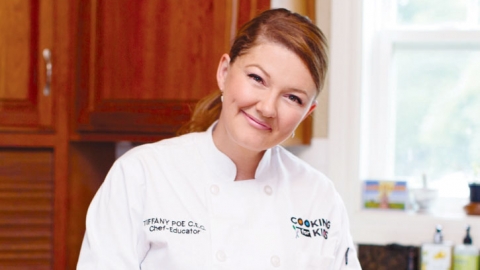Cooking For kids
LABOR OF LUNCH, PART THREE
Chefs helping to make school food more healthful and appetizing
For many years, parents, school officials and legislators alike have been trying to get healthier lunches into our school systems. It has required baby steps in many directions, including passing relevant nutritional guidelines, changing school menus and obtaining healthier ingredients, but ultimately progress has been made.
Similar to the old adage regarding a horse and water, bringing healthy food into our schools doesn’t necessarily mean the kids will eat it. According to a study published last year in Preventive Medicine, researchers examined the lunch trays of 2,000 randomly selected Los Angeles middle school students over five consecutive days. Though the students are offered a fruit and a vegetable each day, 32% of students did not take the fruit from the line, and almost 40% did not take the vegetables. Among those who did take a fruit or vegetable, 22% threw away the fruit and 31% tossed the vegetables without eating a single bite. In essence, just over half the students both took and ate some fruit, and about 42% both took and ate a vegetable. Point taken.
The act of feeding kids a healthy lunch, however, should not stop at the lunch line.
“We need to do more to get our kids well-prepared for an adulthood of eating vegetables with gusto,” said William J. McCarthy, one of the study authors and a health policy professor at the University of California, Los Angeles. “There are downstream medical costs to this in the form of diabetes and heart disease.”
When the Healthy Hunger-Free Kids Act 2010 was passed, the USDA updated school meal patterns and nutrition standards to include less unhealthy fat, less salt, fewer calories, low- and non-fat dairy, double fruits and veggies and more whole grains. The guidelines were implemented in schools starting in fall 2012, but these new guidelines don’t always translate into appealing food.
The challenge has always been how to offer delicious and healthy food, within the budget of the school system, while also adhering to the guidelines put in play by the USDA. One could compare the act of planning school lunch to a walking a tight rope. According to several studies on the subject, there is roughly a dollar spent on food in the average school lunch. The other costs of running a food service operation include labor, equipment, supplies, maintenance, transportation, utilities and more. This brings the total to somewhere between two and three dollars—and doesn’t leave much room for experimentation or non-commodity ingredients.
A few years ago, a pilot program started in Oklahoma that is trying to stretch those baby steps to big strides. The key to the program’s success thus far, however, has not been to focus all of its energy on the kids, but rather getting food nutrition professionals inspired to make more delicious and healthy foods that the children will actually enjoy.
In 2013, Cooking for Kids became an official collaboration between the Department of Education Childhood Nutrition, the Oklahoma State University Department of Nutritional Sciences and our local chef community. It brought together expertise from Oklahoma State University faculty in the departments of nutritional sciences and hotel and restaurant administration, the Oklahoma Cooperative Extension Service, as well as the state Department of Education and certified executive chefs. Cooking for Kids is ultimately funded by the USDA, which gives grants towards school nutrition to go with the new (and ever-changing) USDA guidelines. Now schools across the state have access to professional chefs for training and consultation. The chefs work with school childhood nutrition professionals helping them to prepare meals that will appeal to students while adhering to all of the new federal regulations.
Cooking for Kids’ trial run back in 2010 was set to answer questions for the partnership. Mainly, what ARE the school lunch consumption trends of Oklahoma students? And how willing and ready are Oklahoma school nutrition staff members to use less processed foods?
Simultaneously, Oklahoma State University had been doing plate waste studies and readiness assessments on the schools, testing how ripe the climate is for the program to be successful so change can happen. For the test, participating students were given numbered cards for their lunch trays. Photographs were taken before and after the meal was consumed, and ratings were given to assess how much of each individual food component was eaten. What was learned from the test? The majority of students ate around three-quarters of the entrée serving, half of the grain servings and less than half to none of the fruits and vegetables served. Sounds familiar.
Deana Hildebrand, an associate professor in child nutrition and nutrition education at Oklahoma State University and project lead for the Department of Education, brought chef-instructor Tiffany Poe on board to help create the framework of the instruction program.
“Our number one goal is to train up the childhood nutrition professional community in Oklahoma,” Poe said. “Whether the schools are tiny or large we want to raise the bar for how we see childhood nutrition, and raise the grade of our schools statewide.”
Poe, now senior consultant for Cooking for Kids, orchestrates a culinary boot camp for child nutrition professionals. The chef-led pilot training program, almost like a mini culinary school, provides instruction on knife skills, flavor profiles, miseen place and health implications, and includes a week long program with lots of learning interspersed with practice time. This has proven helpful, since many child nutrition professionals do not have a strong culinary background.
“We know how to make food,” Poe says, referring to the chefs involved. “Now we can help change the paradigm of child nutrition in the state of Oklahoma.”
The multi-component project includes summer regional training for groups, including kitchen managers and head cooks for various educational institutions, as well as on-site chef consultations for program directors and management throughout the school year. Schools are eligible for on-site visits after the school staff has completed both levels of instruction. The consultations include menu and recipe development, help in the procurement of ingredients, equipment assessments, work scheduling and marketing plans and implementations. The training is free to the school districts, thanks to funding by the USDA.
We are all aware that changes are best achieved through the increased use of less-processed foods. This affects purchasing, skills, preparation time, equipment needs and, most importantly, student acceptance of meals. Specifically, the culinary training program will emphasize using fresh, locally grown fruits and vegetables, increasing whole grains and learning food preparation techniques that enhance flavor while reducing sodium.
The Academy of Nutrition and Dietetics recommends a chef-based model—Cooking for Kids’ model provides training to school cafeteria staff, includes menus that meet 2012 nutrition standards and creates meals that taste good and are acceptable to students. During the summer of 2014, six school districts across the state were chosen to pilot the first level of training, and they received the second level of training this past spring: Del City Elementary, Hayes Elementary (Enid), Sterling Elementary, Coweta High School, Lomega High School and Chickasha High School. Cooking for Kids will continue to work with these pilot schools, and the trainings this summer were open to any school district in the state—first come, first served.
The partnership has featured highly qualified industry chefs as instructors, including Tiffany Poe, Robin Obert, Alyssa Densham, Callie Fowler and Edible Tulsa’s editor, Valarie Carter. There is also a large representation of child nutrition directors from around the state.
Cooking for Kids is now five years in. As the program continues to grow, school nutrition professionals will be able to participate in regional training sessions and tap into a website containing recipes, food specifications and nutritional analyses. The ultimate goals of Cooking For Kids are to train all of the 548 school districts in the state of Oklahoma as well as to set up an ambassador program with various school administrations, parents, teachers and students, then put them to work getting people excited about the program.
“For those who are willing and ready to make changes, we want to get them the training and support they need for success,”, says Hildebrand. “Before the readiness assessment with our pilot schools, the school nutrition professionals felt like they didn’t have the necessary resources, and they didn’t understand or value why change was needed. Now they see what what they are doing leads to the bigger picture of the school district, which is getting kids educated.”
And people ARE getting excited, and are eager to spread the good word. Krista Foley, representing Edmond Public Schools said, “I LOVED IT! The curriculum was very upbeat, informative and can be implemented into any daily school cafeteria routine. I personally found that learning the different ways to prepare and introduce new types of foods into the food program, to be the most important. This will certainly be something that I will be introducing into our school.”
Billie Foreman, Food Service Director at North Rock Creek Schools said, “I had a blast at Cooking for Kids 2015. I have been cooking in schools for 20 years and this class was the most enjoyable one yet, I highly recommend more schools attending. I can’t wait to see how the kids at North Rock Creek like the Kale salad with Apple Vinaigrette.”
Cooking for Kids shared a few of their recipes, which have been adapted for home cooking. Try out the Kale Salad with Apple Vinaigrette on your own family, or better yet, let them get in the kitchen with you and start whisking.







